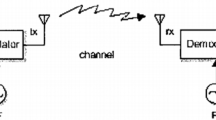Abstract
This paper addresses the initial acquisition for the UMTS-FDD W-CDMA standard. It presents an innovative cell searcher design optimized for acquisition speed and low power consumption [1]. The proposed architecture relies on a memory-based digital matched filter with permuted processing order. We can reconfigure the same filtering hardware to process the three steps of the UMTS-FDD initial cell search, due to a thorough HW/SW codesign, in particular the implementation of an innovative algorithm for the second step of the initial acquisition. The searcher can also perform other functions such as initial delay profiling, neighboring cell search and idle-mode timing alignment, which are typically carried out, at least partially, by the Rake receiver. These additional capabilities allow for further system-level power savings because they avoid activating the Rake and reduce the RF front-end working time to a bare minimum.
Similar content being viewed by others
References
N. Darbel, Y. Rasse, O. Bastidas-Garcia, B. Jubelin, and M. Carrié, “Reconfigurable Low Power Cell Search Engine for UMTS-FDD Mobile Terminals,” IEEE Workshop on Signal Processing Systems, SIPS'02, San Diego, CA, Oct. 2002.
J.M. Rabaey, “Wireless Beyond the Third Generation—-Facing the Energy Challenge,” International Symposium on Low Power Electronics and Design, ISLPED'01, Aug. 2001
A.P. Chandrakasan and R.W. Brodersen, “Minimizing Power Consumption in Digital CMOS Circuits,” in Proceedings of the IEEE, April 1995, vol. 83, pp. 498-523.
3G TS23.211, “Physical Channels and Mapping of Transport Channels (FDD), Release 1999,” 3GPP Technical Specification, 2000.
3G TS23.213, “Spreading and Modulation (FDD), Release 1999,” 3GPP Technical Specification, 2000.
3G TS23.214, “Physical Layer Procedures (FDD), Release 1999,” 3GPP Technical Specification, 2000.
H. Holma and A. Toskala, WCDMA for UMTS: Radio Access for Third Generation Mobile Communication, Revised ed. John Wiley and Sons. Ltd., 2001.
S.W. Oh, C.A. Aldridge, G. Avellone, and M. Sapienza, “Cell-Search Procedure for 3GPP W-CDMA System,” IEEE International Conference on Telecommunications, IEEE ICT2001, June 2001.
N. Darbel and S. Guilley, “Digital Matched Filter,” US Patent Disclosure Serial No. 10/123,881, April 15, 2002
Jun Rim Choi, Lak Hyun Jang, Seong Wook Jung, and Jin Ho Choi, “Structured Design of a 288-Tap FIR Filter by Optimized Partial Product Tree Compression,” IEEE Journal of Solid-State Circuits, vol. 32, no. 3, 1997, pp. 468-476.
N.R. Shanbhag, “A Mathematical Basis for Power-Reduction in Digital VLSI Systems,” IEEE Trans. on Circuits and Systems-II: Analog and Signal Processing, vol. 44, 1997, pp. 935-951.
3GPPTS 34.121, Technical Specification Group Terminals; Terminal Conformance Specification; Radio transmission and reception (FDD) (Release 1999).
N. Darbel, F. Belvèze, and G. Faux, “Code Group Acquisition Procedure for a UMTS-FDD Receiver,” U.S. Invention Disclosure Serial No. 10/151,485, May 17, 2002.
Author information
Authors and Affiliations
Rights and permissions
About this article
Cite this article
Darbel, N., Rasse, Y., Jubelin, B. et al. A UMTS-FDD Cell Search Engine. The Journal of VLSI Signal Processing-Systems for Signal, Image, and Video Technology 38, 73–84 (2004). https://doi.org/10.1023/B:VLSI.0000028554.58523.83
Published:
Issue Date:
DOI: https://doi.org/10.1023/B:VLSI.0000028554.58523.83




